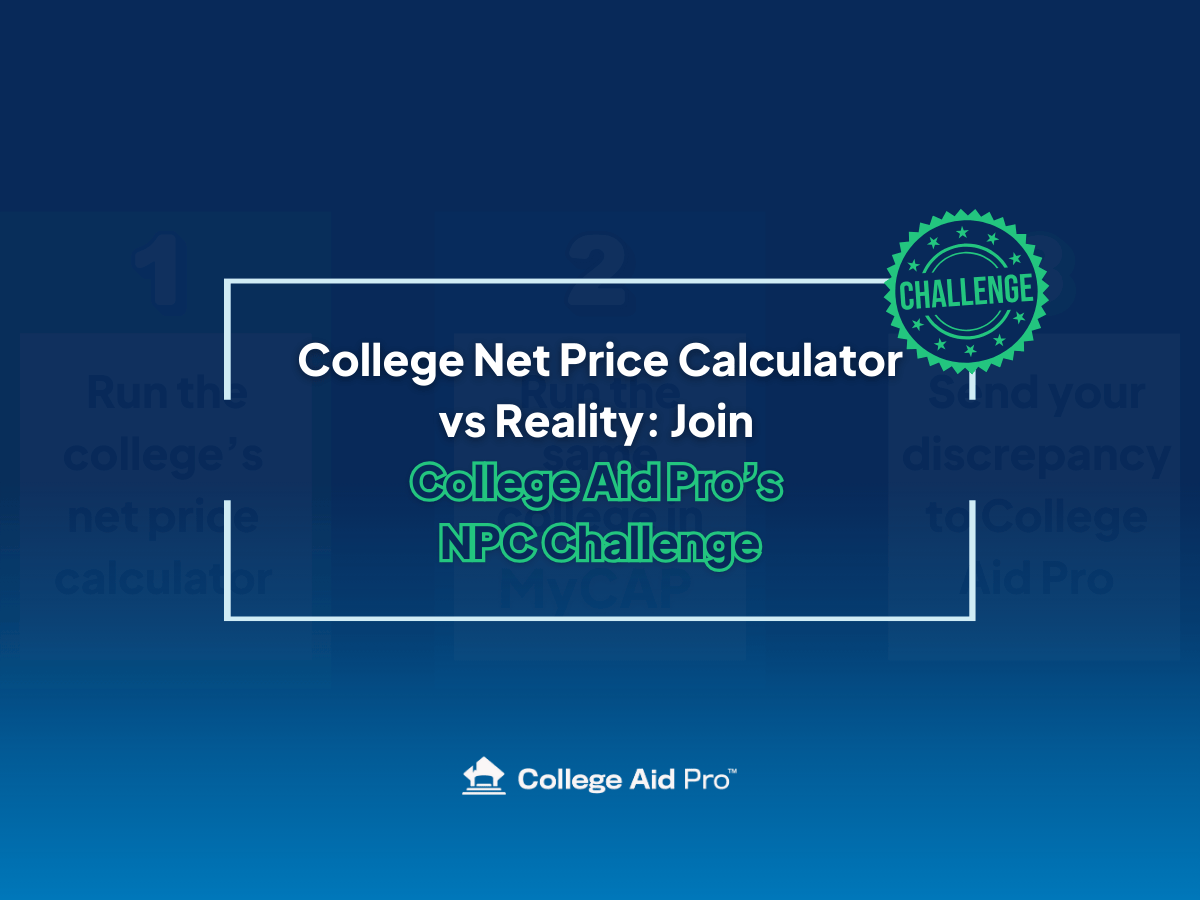Understanding Financial Aid Terms Before You Dive In To College Planning
Let’s face it – the college planning process is a whirlwind of emotions, paperwork, and unfamiliar jargon that can leave even the most seasoned parents feeling lost. It’s completely normal to feel overwhelmed and unsure of where to start, especially when it comes to navigating the complex world of college finances. But take a deep breath, you’ve got this!
At College Aid Pro, we’ve been there, and we understand the roller coaster ride you’re on. That’s why we’ve put together a list of the top 20 financial aid terms every family should know. Consider it your trusty guidebook, designed to help you confidently chart your course through the college financing maze.
College Financial Aid Terms Every Family Should Know
Cost of Attendance
Your cost of attendance (often referred to as COA) is your estimated average price to attend college for one academic year. It includes tuition and fees, room and board, books, and other expenses. This amount is used as the starting point for determining a student’s potential eligibility for need-based financial aid.
Direct Costs
Direct costs are the expenses that you will pay directly to the college such as tuition, fees, and room and board (if your student lives on campus). These costs are usually fixed and can vary based on factors like the meal plan and type of dorm your child will be staying in.
Indirect Costs
Indirect costs are the out-of-pocket expenses associated with being a student that are NOT paid directly to the school. These can include things like books, travel back and forth to school and home, car expenses, public transportation, bills like phone, medical expenses, rent (if you’re living off campus), living supplies that you need for your dorm or apartment, and entertainment for things you want to do outside of classes which are also an important part of the college experience.
Sticker Price
The sticker price is the advertised cost of attendance at a college or university. It is the price that is listed on the school’s website or promotional materials. However, it is not always an accurate representation of what a student will actually pay.
Net Price
The net price is the amount you’ll ACTUALLY pay for college after factoring in financial aid and scholarships. It’s a much more realistic and manageable representation of the true cost of attending a specific institution than the sticker price. The net price considers your family’s financial situation, including income, assets, and household size.
Student Aid Index
The Student Aid Index (SAI) is a number determined by your family’s income and assets. It’s calculated when you fill out the FAFSA and CSS Profile. It is used by colleges to determine your eligibility for need-based financial aid. There are two types of SAI: federal methodology calculated by the FAFSA, and institutional methodology calculated by the CSS Profile. Colleges will subtract your SAI from their total cost to determine your financial aid eligibility. The SAI replaces the Expected Family Contribution (EFC) and is used to help determine how much a family can afford to pay for one year of school.

FAFSA
The FAFSA is the Free Application for Federal Student Aid. It is a form that students need to complete in order to be considered for any type of financial aid at most colleges. It is a free form that can be completed online at the FAFSA website. In order to formally submit the FAFSA, the student and either parent will need to create an FSA ID, which is basically a username and password for electronic signature. The FAFSA takes into account the family’s financial profile, including income and non-retirement assets, to determine eligibility for need-based grants and other types of financial aid. It is an important part of the financial aid process for college.
CSS Profile
The CSS Profile is a financial aid application administered through College Board. It is submitted along with the FAFSA and is required by about 200 mostly private schools, with a few public schools also requiring it. It asks for detailed information about your financial situation, including income, assets, home equity, and real estate. It is more intrusive and asks more questions than the FAFSA. If you are divorced or separated, the custodial parent submits the CSS Profile with the child, and the non-custodial parent submits a separate CSS Profile.
It is important to be honest, not to overshare, and not to overestimate on the form. The CSS Profile uses both parents’ income and asset values, and if the non-custodial parent is remarried, it also uses the step parent’s income and assets. It is important to have tax returns, W-2s, information about assets, real estate, and business ownership handy when completing the CSS Profile. It is more invasive and time-consuming than the FAFSA, but completing it first can make the FAFSA seem easier in comparison.
Need-based aid
Need-based aid is financial assistance that is determined based on a family’s financial profile, including income, assets, and the number of people in the household. It is calculated using the formula: Cost Of Attendance – Student Aid Index (SAI) = Need. Need-based aid is not about the student’s academic profile, but rather about the family’s financial need. It is typically in the form of grants and is intended to lower the sticker price of college for families with demonstrated financial need. It isn’t available at all schools, and the amount of aid a student is eligible for varies depending on the school’s cost of attendance and the family’s student aid index.
Merit-based aid
Merit-based aid is a financial incentive offered by schools to students based on their academic profile, such as GPA, test scores, and extracurricular activities. It is a scholarship awarded to students as a reward for their achievements and is not based on the family’s financial profile. Merit-based aid is typically good for four years and is offered to applying freshmen or seniors in high school. However, it’s important to note that not every school offers merit-based aid, The Ivy League schools DO NOT offer merit-based aid.
Net Price Calculator (NPC)
A net price calculator is a tool that colleges are federally obligated to have on their website. It allows potential attendees to input their financial information and get an estimate of how much they would actually pay if accepted into that particular college.
The accuracy of these calculators depends on the college and the scenario, and they may not take into account certain financial situations such as divorced or separated families, self-employed families, or business owners. The more complex calculators tend to be more accurate, but some colleges may have misleading calculators that do not accurately reflect the actual cost. It’s important to be cautious and not solely rely on net price calculators for a definitive answer.
Want a more accurate and reliable estimate of what YOU would pay at a particular college? Check out our MyCAP software here. You can create a free account here and enter 3 schools.
529
A 529 is an IRS created savings account specifically for college savings. It is used to save for education for a specific beneficiary, and can be set up by parents, grandparents, or anyone else. The account has an owner who designates a beneficiary, and the owner can change the beneficiary or withdraw funds at any time, although there may be penalties and taxes for doing so. The funds can be used for qualified higher education expenses, and there have been recent changes allowing for use for K-12 education expenses up to $10,000 per year.
If the beneficiary receives a scholarship, the owner can withdraw the money with some tax implications. There is also flexibility in transferring the funds to another beneficiary or using the funds for oneself for qualified education expenses. Additionally, leftover funds can be used to create a legacy 529 for future generations. It’s important to consider the impact of a 529 on financial aid eligibility, as well as any state income tax deductions for contributions.
UGMA/UTMA
UTMA (Uniform Transfer to Minors Act) and UGMA (Uniform Gift to Minors Act) accounts are taxable investment accounts set up to benefit a minor, but controlled by an adult custodian (parent, guardian, relative, etc.) until the minor is legally considered an adult. This is usually either 18 or 21, but it varies by state, and it is based on what state the account is based in. At that point, the account assets transfer into the name of the minor, and they take over from there.
UTMA/UGMA accounts help a minor save and invest while also providing flexibility because this money does not have to be used for “qualified educational expenses” like a 529 account. There are no use requirements when it comes to withdrawing money from a UTMA or UGMA.
Demonstrated Need
Demonstrated need is the difference between the Cost Of Attendance and the Student Aid Index (SAI). It is the amount of financial aid a student is potentially eligible for based on their family’s financial situation. This need can be met in various ways depending on the school, such as through scholarships, grants, or loans. However, it’s important to note that just because a student is eligible for need-based aid, it doesn’t guarantee that they will receive that amount, as each college operates differently in meeting the demonstrated need.
Unmet Need
It is the amount of financial aid that a student is eligible for but does not receive, leaving them with a remaining financial burden.
Financial Aid
Financial aid is a discount from the sticker price at a college, which helps reduce the cost of attending college. There are three main types of financial aid: need-based grants, which are based on a student and family’s financial profile; merit-based scholarships, which are based on a student’s achievements and credentials; and self-help, which includes loans and work study. Financial aid is used to make college more affordable for students and can be based on financial need or merit.
Financial Aid Award Letter/Financial Aid Package
A financial aid award letter is a document that a college or university sends to a student that outlines the financial aid package they are offering. It includes details about grants, scholarships, work-study opportunities, and loans that the student is eligible for. The letter also typically includes the total Cost Of Attendance and the Student Aid Index. It is an important document for students and their families to understand in order to make informed decisions about financing their education.
Grants
A grant is a type of financial aid that is typically need-based and does not need to be repaid. It is based on the expected family contribution and can come from the college, state, or federal level. Grants are considered “gift aid” and are part of the first bucket of financial aid, which also includes scholarships. Grants are primarily driven by the family’s financial profile, such as income and assets, and are given by colleges based on their generosity in providing need-based financial aid. Grants are important to maximize as they reduce the cost of attendance for college.
Student Loans
A student loan is a type of financial aid that is given out by the federal government to help students pay for their post-secondary education. To qualify for a federal direct student loan, students need to submit the FAFSA (Free Application for Federal Student Aid). The maximum amount a student can receive over four years of school is $27,000, with specific amounts allocated for each year of study.
It’s important to note that student loans are “use it or lose it,” meaning that if a student doesn’t accept the loan in a given year, they can’t go back and get it in a later year. The interest rate for federal student loans is fixed for the year it is awarded, and there are options for subsidized and unsubsidized loans based on financial need. It’s also worth mentioning that student loans are exclusively under the student’s social security number, and no co-signers are required.
 Scholarships
Scholarships
A scholarship is a form of free money given out by colleges or other organizations to students to help cover the cost of college. It is typically awarded based on criteria such as grades, test scores, leadership, or talent, and is not need-based. There are different types of scholarships, including automatic scholarships, semi-automatic scholarships, and competitive scholarships.
It is important to identify legitimate scholarships and avoid ones that are based on luck or require minimal effort. Some scholarships are renewable, meaning they can be received throughout college, but may have renewal criteria such as maintaining a certain GPA. Some colleges also offer institutional scholarships, which may have separate application processes.
It’s important to understand the difference between merit-based scholarships and need-based financial aid, as not all schools offer merit-based scholarships.
Final Thoughts
Mastering these essential financial aid terms is more than just a checklist; it’s a gateway to a deeper understanding of the college financing landscape. With this knowledge in hand, you’ll be able to make informed decisions, ask the right questions, and confidently advocate for your family’s best interests. Remember, knowledge is power, and at College Aid Pro, our mission is to arm you with the tools you need to make the most of this exciting yet challenging time.
So take a deep breath, embrace the process, and know that you’re not alone. Together, we’ll ensure that your child’s educational dreams become a reality without sacrificing your family’s financial well-being.





